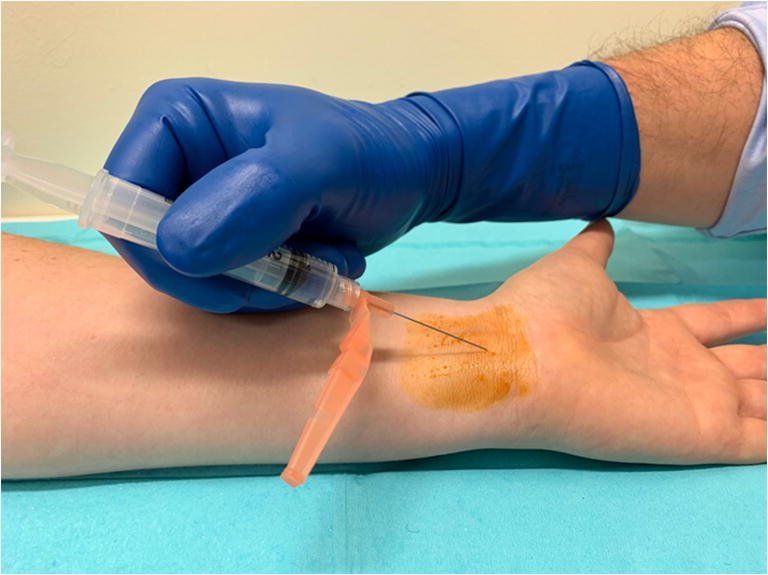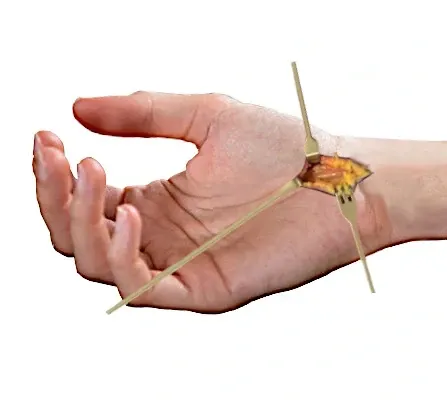Carpal Tunnel Pain Relief at Home
Table of Contents
- Symptoms
- Carpal Tunnel Home Treatments
1) Take Breaks
2) Avoid Stressful or Repetitive Activities
3) Night Bracing
4) Stretching Exercises
5) Keep Hands Warm
6) Wear Protective Gloves
7) Adjust Your Work Environment
8) Wrist Massage
9) Elevate Your Hand
10) Over-the-Counter Medicines
1) Corticosteroid Injection
2) Hydrodissection
3) Surgery
Dr. M. Zannakis | The CarpalRx
Most people with carpal tunnel syndrome find relief using home remedies such as night bracing, stretching, wrist massage, and avoiding repetitive hand stress. About 96% of cases improve without surgery, but severe symptoms may need steroid injections, hydrodissection, or carpal tunnel release surgery.
When carpal tunnel symptoms are mild, they often fade away with rest and simple self-care. As symptoms progress, however, you may need more focused therapy and small lifestyle changes to restore comfort. Severe carpal tunnel syndrome rarely improves on its own — it usually requires consistent, targeted treatment.
Doctors recommend starting with conservative, at-home remedies first. These include rest, avoiding repetitive hand movements, wearing a night brace, doing stretching exercises, and gently massaging the wrist. If those methods don’t provide lasting relief, minimally invasive options like steroid injections or hydrodissection may help. Only the most advanced cases typically require surgery.
In fact, about
96% of the 5 million Americans who experience carpal tunnel syndrome successfully treat it without surgery. This guide explores the
most proven and effective ways to relieve carpal tunnel pain at home — using simple, evidence-based methods that work.
Symptoms
Carpal tunnel syndrome occurs when your
median nerve (a major nerve of the hand) becomes irritated due to compression. This nerve travels through the carpal tunnel passageway deep inside the wrist joint. When tissues around it inflame, they swell and compress the nerve. This produces all of the symptoms of carpal tunnel syndrome.
These symptoms include
pain,
numbness,
burning, tingling, and
shooting electric shocks in the palm and fingers. As carpal tunnel progress, symptoms of the severe stage include
weakness, clumsiness, and loss of temperature sensitivity in the fingers.
Carpal Tunnel Home Treatments
The carpal tunnel pain relief remedies outlined here are perfect when you have mild or moderate symptoms. However, more severe symptoms will likely require
most of these remedies. (Other treatments for severe symptoms are discussed at the end of this article.) Most patients use two or more of the following remedies:
- Take Breaks
- Avoid Stressful or Repetitive Activity
- Night Bracing
- Stretching Exercises
- Keep Hands Warm
- Wear Protective Gloves
- Adjust Your Work Environment
- Wrist Massage
- Elevate Your Hands
1) Take Breaks
Taking short breaks from
harmful or repetitive tasks is crucial. Repetitive hand and finger tasks include activities like playing a
guitar or piano, using hand tools, and sorting items. If this is part of your job, then be sure to stop the activity for a moment every 10-15 minutes. Shake out your hands and wiggle your fingers. These help limber your tendons and improve blood flow. Then, every 30-60 minutes, also incorporate carpal tunnel stretching exercises (see below).
2) Avoid Stressful or Repetitive Activities
For most people, their occupation or hobby is the primary stressor of their fingers and wrist. To help relieve the stress, try to modify your work activity to reduce stress. For example:
- See if ergonomic devices are available to make the job easier on your fingers and hand (i.e., explore using an ergonomic
mouse or
keyboard).
- Adjust your workstation to minimize repetitive hand movements and wrist bending.
- Look out for other
harmful activities that can worsen symptoms.
- Pay attention to your
sitting posture.
3) Night Bracing
While we sleep, we unconsciously flex or extend our wrists. This is very bad if you have carpal tunnel because hyper-bending increases pressure on the median nerve. A carpal tunnel wrist brace will prevent over-bending, and keep your wrist in a neutral position. It's important to wear a brace ONLY
during the night (never during the daytime) and to choose a
certified carpal tunnel brace, and not a pharmacy store wrist brace (because most have palmar spines).
4) Stretching Exercises
Gentle exercises can help relieve pain and improve hand function. Simple stretches include shaking out your hands, making a fist and then extending fingers, and rotating your wrists. More advanced (or "core")
carpal tunnel stretching exercises of the fingers and hand will limber up tendons and lessen inflammation inside the wrist joint. Perform these core stretching exercises 3-4 times per day, and especially after any stressful hand or finger activity.
Click here for exercise details.
5) Keep Hands Warm
A major risk factor for getting carpal tunnel syndrome is working outdoors or in cold environments. That means you must take measures to keep your hands warm. Wear insulated gloves, with finger holes if necessary. Warm hands also help reduce pain and stiffness. Many people will immerse their hands in
ice water to relieve pain. This is a temporary solution and you should not rely on it as a carpal tunnel treatment.
6) Wear Protective Gloves
7) Adjust Your Work Environment
People who work in manual occupations have a higher probability of getting carpal tunnel syndrome. These include farmers,
typists,
hairdressers,
musicians, cleaners, cooks, caterers, and plumbers. See if you can change some tasks to make lifting lighter, twisting less stressful, or alternate hands to pinch. Taking regular breaks is also very helpful.
8) Wrist Massage
Massage your wrist area at least twice daily. In particular, try using
myofascial massage. It is proven to restore damaged tissues, loosen adhesions, reduce inflammation, and improve blood flow. These results are key to eliminating carpal tunnel pain and numbness. Myofascial massage has a
97% effectiveness rate for carpal tunnel syndrome. The
CarpalRx performs this identical massage automatically at home. Caution: Never use a vibration massager because it can cause more harm if you have carpal tunnel syndrome.
9) Elevate Your Hand
Keeping your hand elevated whenever possible can be very effective for pain relief under certain conditions. For instance, when carpal tunnel pain is due to
pregnancy, wrist fracture, or another disorders causing fluid retention, hand elevation is a simple yet effective remedy. That's because hand elevation drains fluid away from the wrist, thereby reducing pressure on the median nerve.
10) Over-the-Counter Medicines
Over-the-counter pain relievers like naproxen (Aleve), ibuprofen (Advil), or acetaminophen (Tylenol) are examples of Non-Steroidal Anti-Inflammatory Drugs or NSAIDs. They help reduce inflammation and swelling. When swelling is controlled, the median nerve is less pressurized, thereby relieving pain. NSAID pain relievers are only a temporary treatment for carpal tunnel pain and numbness. Do not take them daily for more than 3-4 weeks because of
potential damage to your liver and kidneys.
For More Severe Symptoms
As carpal tunnel syndrome advances, symptoms become more
severe and intense. They may require consultation with your doctor. Your doctor may recommend one of the following "minimally invasive" treatments in order to obtain relief:
1) Corticosteroid Injection
This injection into your wrist joint can reduce inflammation and subsequent pain. That's because when inflammation is reduced, the swelling subsides, relieving any pressure on the median nerve. The injections are successful about
45% of the time. They are less effective against more severe symptoms. Also, the injection's effect is usually temporary as most patients see symptoms return in 3-4 months. But due to their potential
side effects, you can only have a limited number of corticosteroid injections.
2) Hydrodissection
Another recommendation your doctor may make is a relatively new procedure called
median nerve hydrodissection. This involves inserting an ultrasound guided needle into your wrist area. The doctor injects fluid in several areas immediately adjacent to the median nerve. The force of the injected fluid pushes away any adhesions that are trapping the nerve. As entrapment lessens, nerve irritation is reduced and symptoms begin to disappear. Very few doctors perform median nerve hydrodissection because it's so new. But it has a 70-75% effective rate. And unlike steroid shots, it can be repeated indefinitely when symptoms return.
3) Surgery
Finally, when all home remedies and minimally invasive therapies fail, then your doctor may recommend surgery. It is called "carpal tunnel release surgery" because it releases the pressure on the median nerve.
There are two basic types of surgery:
open and endoscopic. Both aim to cut the
transverse carpal ligament which squeezes your wrist bones together and crushes the median nerve. When the ligament is cut, your wrist bones snap apart, thereby relieving the crushing pressure on the median nerve.
Generally, the open technique is more often performed, is somewhat safer, involves more
post-surgical pain, more complicated aftercare, and longer
healing time. The endoscopic technique is considered less safe, but offers less post-surgical pain,
less aftercare, and quicker healing time.
Learn more about the pros and cons of each carpal tunnel surgery procedure here.
Summary
Most people get significant relief from carpal tunnel symptoms by using home remedies. These include rest and avoidance, workplace modifications, night bracing, stretching exercise, and wrist massage. More severe cases of carpal tunnel syndrome will likely require multiple remedies applied simultaneously. Also, there are minimally invasive therapy options if the above remedies fail. Surgery is considered the last resort for carpal tunnel symptoms relief.
About










